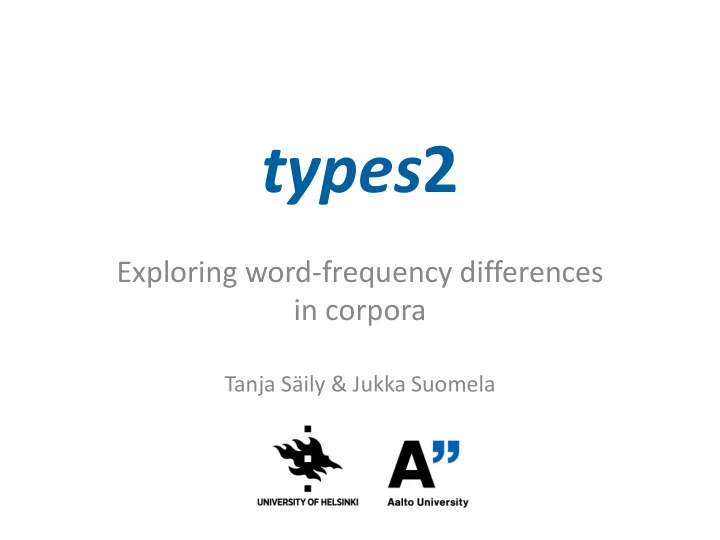

types 2 Exploring word-frequency differences in corpora Tanja Säily & Jukka Suomela
Comparing word frequencies • Corpus linguists do this all the time • Significance of differences observed? – Bag-of-words tests (e.g. chi-square, log-likelihood ratio test) assume words occur randomly in texts, overestimate significance – Tests based on resampling : assumption-free, yield confidence intervals • types 2: permutation testing (resampling)
Exploring word frequencies • Typically: static tables, figures – Not conducive to rapid exploration • Interpretation of results? – Need to go back to the concordances & metadata • types 2: online interface with interactive figures, linked data
How does it work? • Do a corpus search – BNCweb, WordSmith Tools… • Narrow down to relevant hits • Input for types 2: relevant hits + corpus metadata • Output : plots, results, web pages…
Example: Productivity in the BNC • Derivational suffixes: - er , - or – Sociolinguistic variation in their productivity? – Productivity ~ type frequency • BNC = British National Corpus – Demographically sampled spoken component, both gender & social class known: 2.6 Mw – BNCweb (Lancaster University) – MorphoQuantics (Laws & Ryder 2014)
word, POS, Morpho- class, Quantics lemma relevant BNC hits raw BNCweb search plots, results types 2 results, data- web base pages meta- data, word counts
Conclusion • Linked data helps with – Generating hypotheses • Age? Setting? Relationship? – Interpreting results • Male overuse of - er : playful name-calling, focus on tools & occupations? • types 2: free tool, works with multiple corpora & concordancers
References • Laws, J.V. & C. Ryder (2014) MorphoQuantics . http://morphoquantics.co.uk • Laws, J.V. & C. Ryder (2014) Getting the measure of derivational morphology in adult speech: A corpus analysis using MorphoQuantics . Language Studies Working Papers : University of Reading, Vol. 6, 3 – 17. • Suomela, J. (2014) types 2: Type and hapax accumulation curves. http://users.ics.aalto.fi/suomela/types2/ • Suomela, J. (2015) bnc-affix: Analysing productivity of affixes with BNC & MorphoQuantics data. https://github.com/suomela/bnc-affix
Example: Productivity in the CEEC • Derivational suffixes: - ness , - ity – Sociolinguistic variation in their productivity? • CEEC = Corpora of Early English Correspondence – Long 18 th century, 1680 – 1800: 2.2 Mw – WordSmith Tools (Mike Scott) – Pruned down to relevant hits in Excel
“If you find any thing that has the least appearance of coxcombicality , affectation, importance, conceit, &c., have no mercy upon it.” Thomas Twining to Richard Twining, 1788
Recommend
More recommend